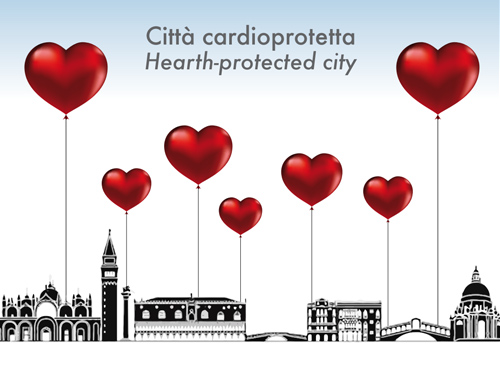The Circulatory Arrest Cardio (ACC) is one of the leading causes of death in industrialized countries. The ACC affects one person in a thousand.
It is estimated that in Europe alone each year more than 300,000 people die of sudden cardiac arrest, in Italy the estimate is between 45,000 and 60,000 per year (IRC Council guidelines 2010-2015).
The ability to save those affected by ACC is reduced by 10% for every minute that passes from the start of the event. After 5 minutes JSB brain and heart suffer irreversible damage that compromise the survival of the patient even if revived, both in quality and quantity of life (ERC guidelines 2010).
If ever there was to be found to provide relief to a person who has just suffered a sudden cardiac arrest, each of us would like to be able to help: the administration of shock from a defibrillator is the only effective treatment.
For these reasons it is essential the presence of a semi-automatic defibrillator, simple to use by anyone who has received adequate training and is present at the place where its use is necessary.
The AED analyzes the heart rhythm of the patient independently and determines whether it is necessary to deliver a shock, the voice instructions and on-screen assist the operator during defibrillation.
Defibrillators are extremely intuitive in their use, require no medical experience to know how to use: just a few hours of training to learn how to save a human life, and the Italian law by Decree Law No. 69 of March 15, 2004, established criteria to use an automated external defibrillator.
Defibrillators should be placed so that patients can be achieved in the shortest possible time by trained persons.
Defibrillators are devices used by computerized simple but extremely safe and reliable, explaining with voice commands and visual rescuer how to intervene in the event of cardiac arrest.
Voice instructions and/or on-screen guide the rescuer during the execution of procedures for cardiac resuscitation. The majority of available models have only two buttons: one for the power on/off and one for the delivery of the shock. In models without ECG display is not necessary for the rescuer to interpret the ECG of the patient, as the defibrillator automatically analyzes it and decides itself whether the rescuer should deliver or not deliver the shock. The rescuer should only apply the adhesive electrodes on the patient's chest as shown on a drawing on the electrodes themselves.
If the diagnosis by the defibrillator does not provide for the delivery of the shock, the defibrillator is a device so sure that even accidentally pressing the shock button is not supplied electrostatic discharge.
The choice, which began with a project of hoteliers Venetians, to create a network to gradually cover the whole territory of Venice is the basis of the "Venice heart-protected city". Over 50 defibrillators AEDs in strategic locations in Venice, high tourist attendance (public places, hotels, shops, medical offices), kept in heated display cases and windy, with audible alarm when opened.
The maintenance of the equipment is carried out by technicians of ULSS 12 Veneziana, who is also the training of operators of participating hotels, Municipal Police, harbor master, Police airborne.
PREVENTABLE FACTORS KNOWN TO PREVENT CARDIOVASCULAR:
You are a lucky tourist here in Venice, because this city encourages you to keep walking.
However, remember to drink more water than usual, and eating fresh fruits and vegetables more often. Avoid exposure during the hottest hours of the day (12 pm to 5 pm), wearing a hat and light clothing in light colors.
If you need assistance, you can contact our health care centers:
